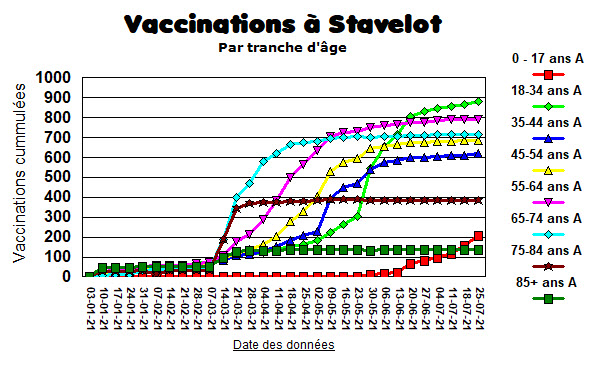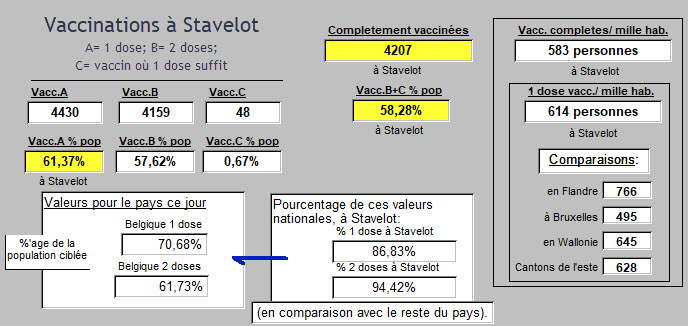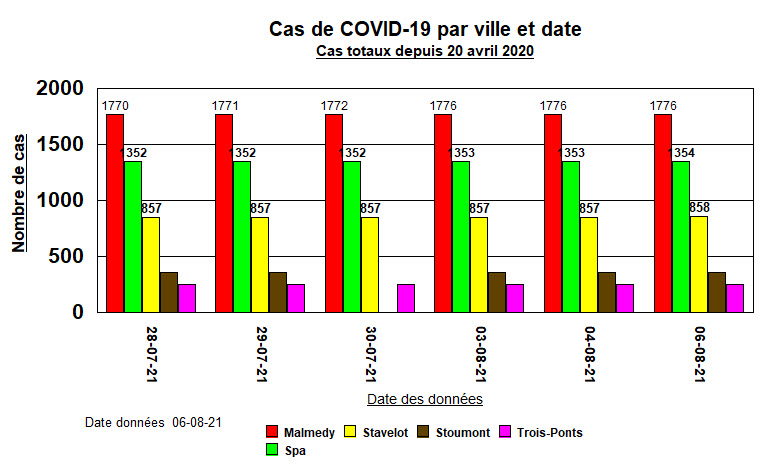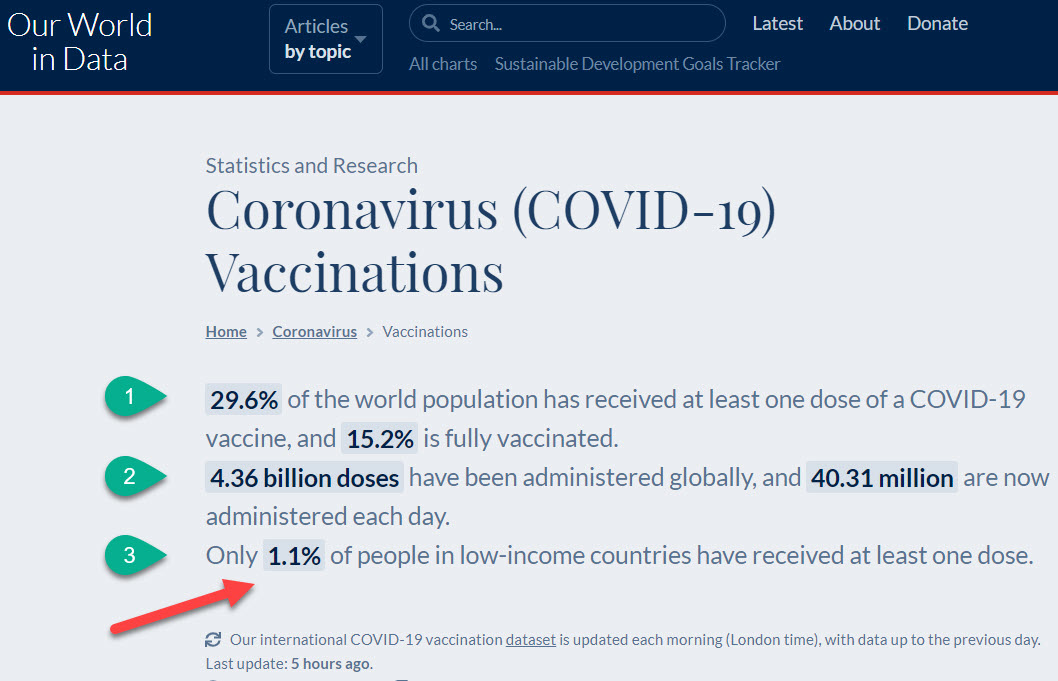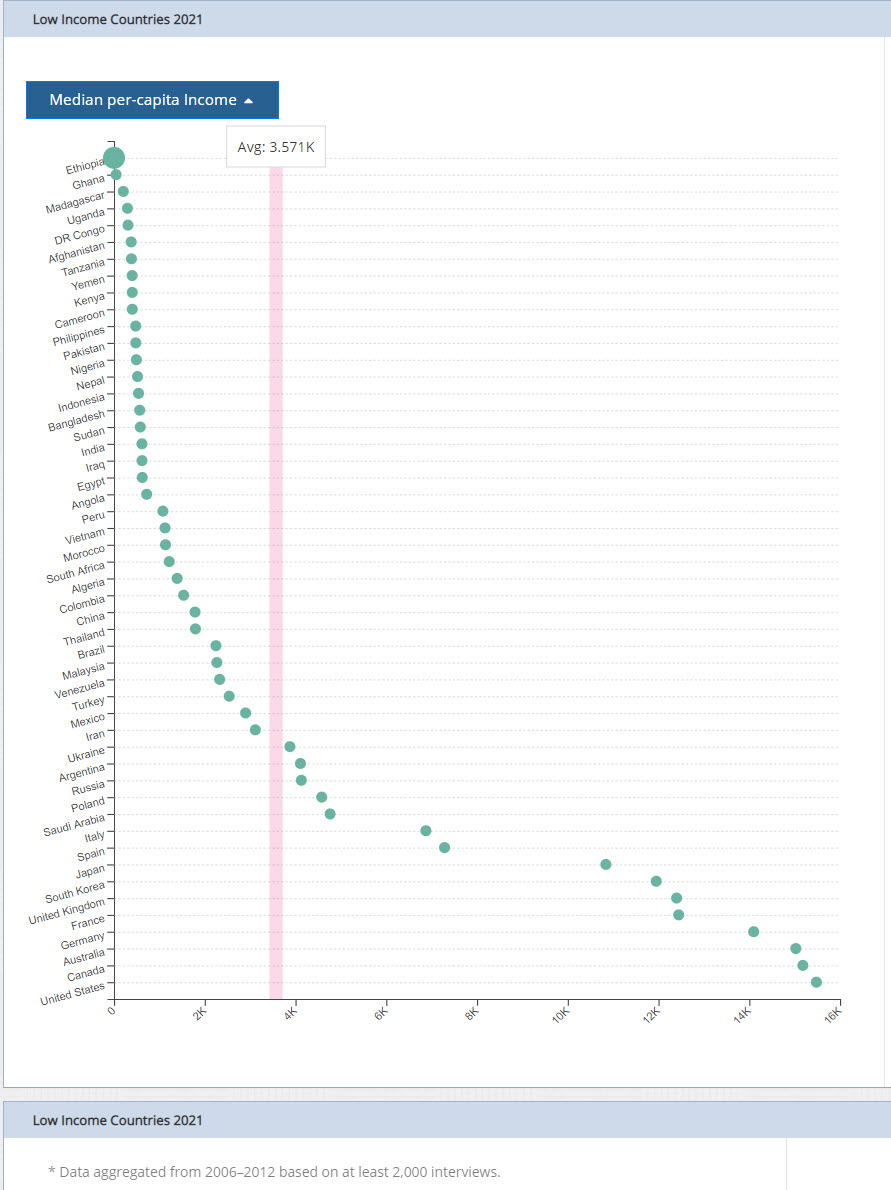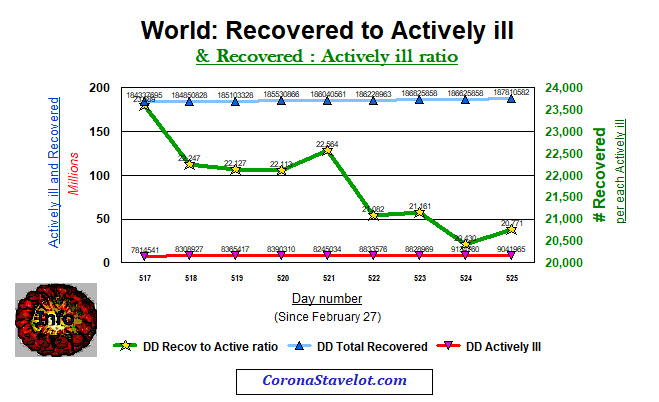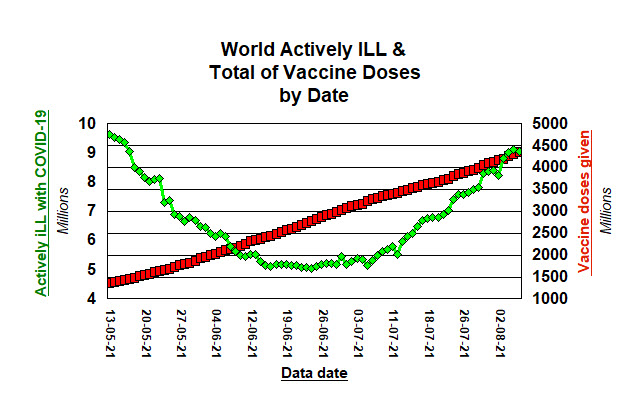Let's widen our perceptions
CoronaSTAVELOT.com
Thanks for visiting!
To translate this page, select your
language from the dropdown menu below:
Servez-vous du traducteur ci-dessus si besoin.
If you hadn't noticed, the COVID-19 pandemic is still going on.
Let's backtrack to a key point in the lessons that most have now mastered.
The experts said: (paraphrased) "If the vaccines are going to stop this virus, a level of herd immunity of 60 to 70% in a population will have to be reached."
And where are we now?
Well, where would you like to look? Very, very locally, or at the world?
Evolving a pandemia-related type of tunnel vision, helps one to make it calmly through the day.
Locally where I am (in Belgium) things look like this ...
The vaccinations in one city are sorted below by age groups.
So, a slow start back in January. A push to get the elderly vaccinated by end of March, (the flat lines above mean not a lot of recent vaccinations for that subgroup). Vaccination of those 18 to 24 years picking up towards end of May. Children and adolescents starting at end of June, but still a small percentage of the total.
One can move out just a bit further to compare different regions of Belgium with this same city, where 58% of the citizens have full vaccine coverage.
And out of these comparisons, a correct impression arises that this city's performance is not the best result when compared with other regions, but not bad.
Progress is being made.
A target in Belgium had been set at vaccinating with at least one dose 9 180 601 Belgians of 18 years and older. (Belgium's population is just over 11.46 million inhabitants).
That goal was met. 14,870,000 doses have been administered, or 162% of that target. At present, an average of 45,419 vaccinations are administered each day here in Belgium.
Is that enough? Was that initial target meanigful? Has it stopped the virus in Belgium?
Is vaccination getting the job done? If answered for the local data here, it is also a meanigful question to be posed throughout the world. Vaccination has been thought of by many as a global "off-switch." That is likely to be proved wrong. That vaccination by itself will not be enough seems to be an increasingly supported theme.
Locally in 13 cities near the one just presented, cases continue to creep up, very, very slowly.
None of these local towns have found a way to make the numbers stop growing. Slowly growing at present, but not stopped. Here are 5 of these towns, showing numbers of total cases since late July.
If the experts reappeared, they might quietly remind that 58% vaccinated is not 70%.
But is that local perspective, like using a magnifying glass, the right one?
The above city is located in the Province of Liège.
There, the incidence of COVID-19 is currently 12,133.6 cases per 100,000 inhabitants.
And that today, presents a slight but constant increase in daily incidence figures over the last weeks.
Incidence involves defining a period of observation. So an image of walking around with a clipboard for a week and counting all the cases one could find is not too far off as explanations go. Could be reported for a year or other selected interval of observation as well. Once one has a method down, it can be applied to comparisons.
Just to the east in Luxembourg it's 11,863.39 per 100,000. A bit further to the east in the Rhineland of Germany, its 3,876.48 per 100,000.
Are those incidence results due to important differences in management by Public Health sectors of government? How much is policy? How much is public behavior?
In Algeria the incidence is 405.95 per 100,000 inhabitants.
In Ghana its 342.53 per 100K.
In Somalia, 99.0 per 100K.
Are those good numbers from a perspective of reporting accuracy? Can we believe them?
Hard to say. They are from the same source.
Not clearly related perhaps, Luxembourg has the highest GDP-PPP$ rating in the world, ranked number 1 at 118,001$.
Somalia is near the bottom of the list, ranked number 192 at 923$.
Luxembourg's COVID-19 incidence rate is 120 times higher than that of Somalia.
Bad numbers? Or does the ability to pay for vaccines for one's population not solve the problem?
Clearly, as many European countries prepare to decide about a third dose of vaccine for their inhabitants, (Israel and Germany have already started) many countries that are ranked lower on the income ladder have yet to start.
Here are those global vaccination data today:
At #1: 29.6% and 15.2% as presented, based on the target proposed by the experts, means that at a World level, we're not even close to 60 or 70%.
At #2: The vaccination numbers sound huge. They are huge: 4.4 billion of anything is huge.
40 million people vaccinated each day is huge. So it's easy to form a mental image that we'll be done soon.
At #3: Yet another worldly maldistribution problem appears. "1.1% of people in low-income countries have received at least one dose."
1.1% of anything seems very small. Of course, multiply out 1.1% of these populations, add them up, and it's lots of people.
Which are the "low-income countries"? How many of them are there?
Well, those who count such things find about 24 countries where average median per capita income is below a line drawn at 3.571 thousand.
Such data can be found here, from the International Monetary Fund. Or here in PDF in a quite complete document.
Such data might also quickly lead this article into a sticky discussion of what is fair in the business of world vaccination distribution and availability. Finding "fair" may be one approach. Finding "possible" means something else.
Let's once again retreat just a moment to a more local perspective.
In Belgium today, total numbers, 1 134 907 cases of COVID-19. Responsible for 25 264 Deaths.
With 1 062 447 who were infected, now counted as Recovered.
That leaves 47 196 Actively Ill with COVID-19 today in Belgium. In 47 104 cases (99.8%), a mild illness, and at present, 92 (0.2%) serious or critical.
Being ignored completely in those figures is the difference between counted cases (positive tests) and number infected and loose in the streets available for further transmission of the virus. (Ten to 12 times the other number).
Since we mentioned the subgroups of those Actively iLL and Recovered, the ratio of the two in the reported cases for the world looks like this recently:
Simply put (as shown by the green line above) there are about 21 individuals who were sick who have now recovered, for each individual who is currently still Actively iLL. Certainly, that's good news, though the trend is currently downwards.
Those numbers may lean us towards a conclusion that the vaccination effort is effective and that the battle is being won. Maybe its the vaccine. It's probably a combined effect of several other things as well.
It remains that nothing in this COVID-19 situation today is free from uncertainty.
Uncertainty has become the by-word for daily existence. Let's look at this below:
Going back to mid-May, about 1.5 billion doses of vaccine given (right side of the graph, in red).
Cases of Actively iLL (in green, left side) trended downwards, and bottoming at end of June.
But since? As the big numbers for vaccination methodically rose (to almost 4.5 billion today),
so did the millions of individuals Actively iLL with COVID-19.
Why?
The experts would safely suggest that 15.2% fully vaccinated in our world isn't 70%.
Some of them might remind that this pandemic all began with just a relatively small (by comparison with today) number of cases. We have been living all those scary geometric-growth-in-transmission numbers right from the start. And each time that a downward slope seems to bottom out to give us hope, an upward trend has unfortunately begun once again and all to soon.
The experts might summarize : "... still need to get more people vaccinated."
So who isn't vaccinated?
Yes, there are the anti-vaxers and those who have been stalling to see who would drop dead from brain clots or get Guillain-Barré after the jab of Astra-Zeneca or any other vaccine.
As the well-to-do-countries winnow their way towards a third dose of vaccine, (you'll find them at the top of this list), the folks at the bottom of that list just don't seem to want to go away as the problem of non-vaccination gets analyzed and summarized.
One can approach that problem with discussions about countries that are in red zones or lighter shades of pink. One can carefully incorporate daily changing recommendations for travel, into a planned and sorely needed vacation. One can even start discussions and reactions to, about whether we should be making efforts to get someone in Somalia vaccinated, when that person might just be a Somali pirate. Perhaps the close friend of a murdering dictator in some other "low-income" country is awaiting a vaccine as well.
That's not it.
One can feel pushed to act fast by reports from those on the medical front line that this Delta-variant illness is once again, ... a source of important uncertainties. Those catching the thing and getting quite sick at times, seem to be the "younger, sicker, quicker" to decompensate group of patients. We have mastered saving all the elderly in Nursing Homes. It's not them anymore.
Do we just need to learn a little bit more about all of this?
More armchair epidemiologists needed? Is that it?
Let's take a break for a little video ...
(You can leave your PC's sound on, this video is silent).
This comes from a great page that you can find here at Worldometer.
I'll show my bias right off the bat, but let's pick one activity that has replaced music lessons or playing chess.
Spent on Video Games TODAY : 225 668 712 million dollars. Today.
A dose of AstraZeneca vaccine here in Belgium sells for 1.78€ (2.093$US).
So a day's worth of Video Games buys: 107.820.694 doses of AstraZeneca vaccine (assuming the same price as just given).
Population of Somalia? 16 375 690.
(16 375 690 x 2) = 32 751 380
A day's worth of Video Games fully vaccinates everyone in Somalia, and leaves 75 069 314 doses for some of the other "low-income" countries.
I can hear it already: "You're going to ask me to give up buying a Video Game so somebody can vaccinate a Somali pirate ? !"
Answer: "Yup. We'll vaccinate the bastard."
Why would one do that?
Well, if one is only interested in protecting one's own health, so that the downstream contacts of that Somali pirate, don't bring the virus to your home for your end-of-year Holidays.
Look again at that little one minute video above. Notice what is now occupying our social existence. Think about what occupied our existence and those of our parents about 50 or so years ago. Even more recently.
How many times did you check your eMail today?
Our world has changed.
But if we want to keep it, now is the time to think our way out of this box, face the uncertainties, create possibilities, and get a move on.
Or we can wait to see which of the Ten Plagues reappears next. We've had Mad Cow Disease, a need to destroy Minks in Denmark, Fires and Floods, and Locusts, and we've got the Pandemic now. What's next?
It's time to start dreaming a way out, that includes others besides ourselves.
Inscrivez-vous au blog
Soyez prévenu par email des prochaines mises à jour
Rejoignez les 15 autres membres

